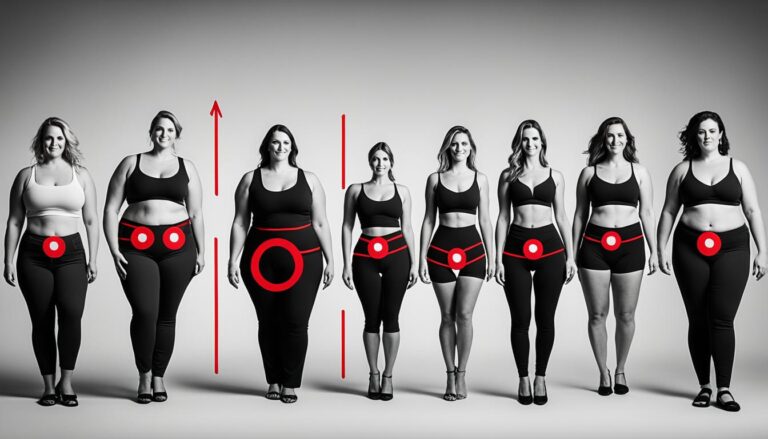Does Mom Belly Ever Go Away?
If you’re wondering, “Does mom belly ever go away?” you’re not alone. Many new mothers are eager to regain their pre-baby shape and wonder if their postpartum belly will ever disappear. The postpartum belly, also known as the “mom belly,” can take time to go away after pregnancy. After giving birth, both the stomach and uterus will start to contract, but it may take around six weeks for the uterus to fully contract. Breastfeeding can also aid in weight loss, as it burns around 500 calories per day. It’s important to listen to your body and not push yourself too hard, as it can take time for your stomach to return to its pre-pregnancy shape. Some women may also experience abdominal separation, which can be healed with specialized exercises or, in severe cases, through surgery. Additionally, exercise, a healthy diet, good posture, and mental health support can all be factors in improving the postpartum belly.
Key Takeaways:
- The postpartum belly can take time to go away after pregnancy.
- Both the stomach and uterus will start to contract after giving birth, but it may take around six weeks for the uterus to fully contract.
- Breastfeeding can aid in weight loss as it burns around 500 calories per day.
- Abdominal separation may occur, which can be healed with specialized exercises or surgery in severe cases.
- Regular exercise, a healthy diet, good posture, and mental health support can all contribute to improving the postpartum belly.
Understanding the Postpartum Belly
The postpartum belly, also known as the mommy tummy or post-partum pouch, refers to the softness and extra weight that many women experience in their abdominal area after giving birth. It is a common and natural part of the postpartum journey, as the body goes through significant changes during pregnancy and childbirth.
After giving birth, both the stomach and uterus will start to contract. However, it may take around six weeks for the uterus to fully contract and return to its pre-pregnancy size. This gradual process allows the body to heal and adjust after the physical strain of pregnancy. During this time, it is normal for women to still have a protruding belly and feel a bit heavier than before.
Factors such as genetics, weight gained during pregnancy, and muscle tone can all contribute to the appearance of the postpartum belly. Additionally, hormonal changes and the stretching of the abdominal muscles during pregnancy can result in a separation known as diastasis recti. This can further contribute to the softness and protrusion of the belly.
While it is natural for the postpartum belly to take time to go away, there are steps that can be taken to support the body’s recovery process. Breastfeeding, for example, can aid in weight loss as it burns around 500 calories per day. Engaging in exercises that target the core muscles and following a healthy diet can also help in losing baby weight and toning the abdominal area. It is important, however, to listen to your body and not push yourself too hard. Every woman’s postpartum journey is unique, and it is essential to give yourself time and patience as your body heals and adjusts.
Factors Affecting the Rate of Belly Reduction
Several factors can influence the rate at which the mom belly goes away, including breastfeeding, targeted exercises, and adopting healthy habits. Breastfeeding is not only beneficial for the baby but can also aid in weight loss for the mother. It has been found that breastfeeding burns approximately 500 calories per day, which can contribute to shedding those extra pounds. So, if you’re able to breastfeed, it’s a great way to kickstart your journey towards a flatter mom belly.
Mom belly exercises are another important factor in reducing the postpartum belly. Incorporating targeted exercises into your routine can help strengthen and tone the abdominal muscles, ultimately leading to a more defined and flat tummy. These exercises can include pelvic tilts, crunches, planks, and gentle yoga poses specifically designed for postpartum recovery. Remember to start slow and listen to your body, gradually increasing the intensity and duration of your workouts as you regain your strength.
Adopting healthy habits, such as maintaining a balanced diet and staying hydrated, can also contribute to reducing the mom belly. A diet rich in lean proteins, fruits, vegetables, and whole grains can provide the necessary nutrients for healing and overall well-being. Additionally, staying hydrated helps support digestion and can prevent bloating, which may make your belly appear larger than it actually is.
Lastly, don’t forget to pay attention to your mental health. The postpartum period can be challenging, and stress or emotional fluctuations can affect your body. Engaging in activities that promote mental well-being, such as meditation, deep breathing exercises, or seeking support from loved ones or professionals, can have a positive impact on your overall health and aid in the reduction of the mom belly.
| Factors | Effect on Mom Belly Reduction |
|---|---|
| Breastfeeding | Burns calories and aids in weight loss |
| Mom belly exercises | Strengthens and tones abdominal muscles |
| Adopting healthy habits | Supports overall well-being and reduces bloating |
| Mental health support | Promotes emotional well-being, reducing stress |
Healing Abdominal Separation
Abdominal separation, also known as diastasis recti, is a common condition that can occur during pregnancy and contribute to the appearance of a post-pregnancy belly. It happens when the connective tissue between the left and right abdominal muscles becomes stretched and weakened. This can result in a separation of the muscles, leaving a gap in the midline of the abdomen.
To heal abdominal separation, it is important to engage in targeted exercises that focus on strengthening the core muscles. These exercises, such as pelvic tilts and abdominal compressions, can help bring the separated muscles back together and restore abdominal stability. Working with a physical therapist or a postnatal exercise specialist can provide guidance and ensure that you are performing the exercises correctly.
Example table: Exercises for Healing Abdominal Separation
| Exercise | Description |
|---|---|
| Pelvic Tilts | Lie on your back with knees bent. Gently tilt your pelvis upward, engaging your abdominal muscles. Hold for a few seconds and then release. |
| Abdominal Compressions | Stand tall with your feet shoulder-width apart. Place your hands on your belly and exhale deeply, pulling your belly button in towards your spine. Hold for a few seconds and then release. |
| Planks | Start in a push-up position, resting on your forearms. Keep your body in a straight line from head to toe, engaging your abdominal muscles. Hold for a set amount of time and then release. |
In some cases, if the separation is severe or does not respond to exercise, surgery may be recommended. Abdominoplasty, commonly known as a tummy tuck, is a surgical procedure that can repair abdominal separation and remove excess skin and fat. However, it is important to consult with a healthcare professional to determine the best course of action for your specific situation.
Note: The information provided in this article is for informational purposes only and should not be considered medical advice. Please consult with a healthcare professional before starting any exercise program or undergoing any surgical procedures.
Tips for Achieving a Flatter Mom Belly
If you’re looking to flatten your mom belly and regain your pre-baby shape, incorporating exercise, maintaining a healthy diet, practicing good posture, and prioritizing your mental health are key. While it’s important to remember that everyone’s postpartum journey is different, these tips can help you work towards your goals.
Exercise
Regular exercise is crucial for toning your abdominal muscles and reducing belly fat. Focus on exercises that target the core, such as planks, crunches, and pelvic tilts. Including cardio activities like walking, jogging, or swimming can also help burn calories and promote overall weight loss. It’s important to start slowly and listen to your body. Gradually increase the intensity and duration of your workouts as you regain strength.
Healthy Diet
A balanced and nutritious diet is essential for overall health and weight management. Incorporate whole foods like fruits, vegetables, lean proteins, and whole grains into your meals. Avoid processed foods and sugary snacks that can contribute to weight gain. Remember to stay hydrated by drinking plenty of water throughout the day. Consulting with a registered dietitian can provide personalized guidance and support.
Good Posture
Practicing good posture can help strengthen your core muscles and improve the appearance of your belly. Stand tall and align your head, shoulders, and hips. Engage your abdominal muscles and avoid slouching or arching your back. Incorporating exercises that target your posture, such as yoga or Pilates, can also be beneficial.
Mental Health Support
Don’t forget about the importance of taking care of your mental well-being. The postpartum period can bring about a range of emotions, and it’s crucial to prioritize self-care. Seek support from loved ones, join a new moms’ group, or consider speaking with a therapist if needed. Taking time for yourself and managing stress can have a positive impact on your overall health, including your physical well-being.
| Exercise | Healthy Diet | Good Posture | Mental Health Support |
|---|---|---|---|
| Target core exercises like planks and crunches | Incorporate whole foods and avoid processed snacks | Practice good posture by aligning head, shoulders, and hips | Seek support from loved ones or therapists if needed |
| Include cardio activities like walking or swimming | Consult with a registered dietitian for personalized guidance | Incorporate posture-improving exercises like yoga or Pilates | Take time for self-care and manage stress levels |
While achieving a flatter mom belly takes time and patience, incorporating these tips into your daily routine can help you reach your goals. Remember to be kind to yourself and celebrate every small victory along the way. Your body has gone through an incredible journey, and with dedication and self-care, you can regain your pre-baby shape.
Conclusion
While the mom belly may not disappear overnight, it is possible to achieve a flatter tummy with patience, dedication, and a holistic approach that encompasses various aspects of postpartum recovery. After giving birth, the stomach and uterus will begin to contract, but it can take around six weeks for the uterus to fully contract. During this time, it’s important to listen to your body and not push yourself too hard. Remember, your body has just gone through an incredible journey, and it needs time to heal.
Breastfeeding can also play a role in weight loss, as it burns around 500 calories per day. However, weight loss should not be rushed, as your body needs nutrients and energy to recover. A healthy diet, rich in fruits, vegetables, lean proteins, and whole grains, can provide the nourishment needed for healing and help shed any excess weight gradually.
Exercise is another important factor in improving the postpartum belly. Engaging in light to moderate physical activity, such as walking, swimming, or postpartum-specific exercises, can help strengthen the abdominal muscles and promote overall fitness. However, it’s crucial to consult with a healthcare professional before starting any exercise routine to ensure it is safe and appropriate for your individual circumstances.
Lastly, don’t underestimate the power of posture and mental health support in achieving a flatter mom belly. Maintaining good posture throughout the day can help activate the core muscles and improve the appearance of the belly. Additionally, seeking emotional support and practicing self-care can have a positive impact on your overall well-being, which in turn can contribute to a healthier body.
Remember, every woman’s journey is unique, and it’s important to embrace your body and give it the time and care it needs. With a combination of exercise, a healthy diet, good posture, and emotional well-being, you can take steps toward achieving a flatter mom belly and feeling confident in your postpartum body.
FAQ
Q: Does mom belly ever go away?
A: Yes, the mom belly can go away over time, but it may take several weeks after giving birth for the stomach and uterus to fully contract.
Q: What factors contribute to the postpartum belly?
A: The postpartum belly is a result of the physical changes that occur in the abdomen during and after pregnancy. The growth of the uterus and increased fat storage in the abdominal area contribute to the mom belly.
Q: How can breastfeeding help in losing weight and reducing the mom belly?
A: Breastfeeding can aid in weight loss as it burns around 500 calories per day. This can contribute to the reduction of the mom belly. It’s important to note that individual results may vary.
Q: How can abdominal separation be healed?
A: Abdominal separation, also known as diastasis recti, can be healed through specialized exercises that target the deep abdominal muscles. In severe cases, surgery may be necessary to repair the separation. It is recommended to consult with a healthcare professional for personalized advice.
Q: What are some tips for achieving a flatter mom belly?
A: To achieve a flatter mom belly, it is important to engage in regular exercise, maintain a healthy diet, practice good posture, and seek mental health support. These factors can all contribute to improving the appearance of the postpartum belly.
Q: Does mom belly ever go away completely?
A: While the mom belly can significantly improve, it is important to note that every woman’s body is different and results may vary. It is possible for the stomach to return to its pre-pregnancy shape with patience and a combination of factors like exercise, a healthy diet, good posture, and emotional well-being.







